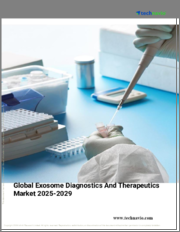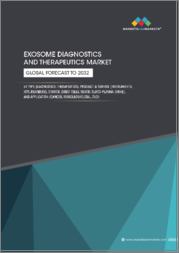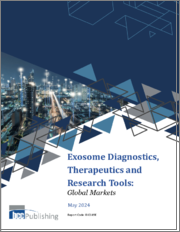
|
시장보고서
상품코드
1475836
세계의 엑소좀 진단 및 치료 시장 규모 및 예측 : 용도별, 제품별, 최종사용자별, 지역별 분석(2023-2030년)Global Exosome Diagnostic and Therapeutic Market Size Study & Forecast, By Application By Product By End User and Regional Analysis, 2023-2030 |
||||||
세계의 엑소좀 진단·치료 시장 규모는 2022년에 약 3억 7,564만 달러에 달하며, 2023-2030년의 예측 기간 중 29.4% 이상의 건전한 성장률로 추이할 것으로 예측됩니다.
엑소좀 진단·치료란 세포로부터 분비되는 작은 막소포인 엑소좀을 다양한 의료용도에서 진단 및 치료 목적으로 사용하는 것을 말합니다. 엑소좀에는 단백질, 핵산(DNA, RNA, 마이크로 RNA 등), 지질, 대사 산물 등 다양한 생체 분자가 포함되어 있으며, 이는 모세포의 생리적, 병리학적 상태를 반영합니다. 엑소좀은 다양한 질병의 진단과 예후를 위한 귀중한 바이오마커로 작용합니다. 엑솜은 혈액, 소변, 타액 등 체액으로 방출되기 때문에 비침습적으로 진단 정보를 얻을 수 있는 비침습적 방법을 제공합니다. 엑소좀 진단 및 치료 시장은 만성질환 유병률 증가, 분자진단 수요 급증 등의 요인으로 인해 확대되고 있습니다. 그 결과, 2023-2030년의 예측 기간 중 국제 시장에서 엑소좀 진단 및 치료에 대한 수요가 점차 증가하고 있습니다.
만성질환은 효과적인 관리를 위해 조기 발견과 지속적인 모니터링이 필요한 경우가 많습니다. 엑소좀은 단백질, 핵산, 지질과 같은 생체 분자를 운반하는 세포를 반영하는 분자 시그니처를 포함하고 있습니다. 엑솜의 함량을 분석함으로써 임상의는 기존 방법보다 더 일찍 질병 특이적 바이오마커를 검출할 수 있으며, 적시에 개입하고 질병 진행을 모니터링할 수 있습니다. 유엔 보고서에 따르면 만성질환은 전 세계 사망자의 70%를 차지하며, 2030년에는 전 세계 질병 부담의 56%를 차지할 것으로 예측됩니다. 아프리카와 동지중해 지역에서 가장 큰 성장이 예상됩니다. 또한 엑소좀 생물학 및 질병 발병에 대한 이해도가 높아지면서 엑소좀 진단 및 치료 분야의 연구개발에 박차를 가하고 있습니다. 여기에는 엑소좀 바이오마커 발굴, 첨단 분리 및 검출 기술 개발, 엑소좀 기반 치료법 개발 등이 포함됩니다. 엑소좀 진단 및 치료 시장을 촉진하는 또 다른 중요한 요인은 분자진단에 대한 수요 증가입니다. 분자진단은 분자 수준에서 질병에 대한 보다 정확한 이해를 통해 개인화된 치료 전략을 가능하게 합니다. 엑소좀은 세포에서 방출되는 미세한 소포로, 모세포의 상태를 반영하는 귀중한 분자 정보를 담고 있습니다. 단백질, 핵산, 지질을 포함한 엑소좀의 내용물을 분석하면 분자진단이 가능해져 암, 감염, 신경 질환 등 다양한 질병을 나타내는 특정 바이오마커를 쉽게 검출할 수 있습니다. 또한 프론티어 오가니제이션에 따르면 줄기세포 유래 엑소좀에는 세포 증식과 조직 치유를 자극하는 성장인자 및 신호전달 분자가 포함되어 있습니다. 엑소좀 기반 치료법은 심장병, 조직 손상 등의 증상에 대해 연구되고 있습니다. 또한 의약품 개발에서 엑소좀 기술의 발전과 번역 정밀 의학의 발전은 예측 기간 중 시장에 유리한 성장 기회를 제공할 것으로 예상됩니다. 그러나 엑소좀 기반 치료제의 높은 개발 비용과 의약품 승인에 대한 정부의 엄격한 규제는 2023-2030년의 예측 기간 중 전체 시장 성장을 저해할 것으로 예상됩니다.
세계 엑소좀 진단 및 치료 시장 조사에서 고려된 주요 지역은 아시아태평양, 북미, 유럽, 라틴아메리카, 중동 및 아프리카입니다. 북미는 이 지역의 만성질환의 유행으로 인해 2022년 시장을 장악했습니다. 미국 질병예방통제센터(CDC)에 따르면 미국 성인 10명 중 6명이 만성질환을 앓고 있습니다. 만성질환을 효과적으로 관리하기 위해서는 조기 발견과 지속적인 모니터링이 필요한 경우가 많습니다. 엑솜 기반 진단법은 암, 심혈관 질환, 신경 질환과 같은 질병을 조기에 발견할 수 있는 비침습적이고 민감한 방법을 제공합니다. 이러한 진단을 통해 의료진은 질병의 초기 단계에 개입할 수 있으며, 환자의 예후를 개선할 수 있습니다. 이 지역의 압도적인 실적은 전체 엑솜 진단 및 치료제 수요를 촉진할 것으로 예상됩니다. 또한 아시아태평양은 헬스케어 지출 증가 등의 요인으로 인해 예측 기간 중 가장 빠른 성장세를 보일 것으로 예상됩니다. 의료비 지출 증가는 병원, 연구시설, 진단 실험실 등 의료 인프라의 확장 및 현대화로 이어지는 경우가 많습니다. 이러한 인프라의 확장은 엑소좀 기반 진단 및 치료제의 개발, 시험 및 상용화에 필요한 자원과 시설을 제공할 수 있습니다.
본 조사의 목적은 최근에서 다양한 부문과 국가의 시장 규모를 정의하고, 향후 수년간 가치를 예측하는 것입니다. 조사 대상국에서 산업의 질적·양적 측면을 도입하도록 설계되고 있습니다.
또한 시장의 향후 성장을 규정하는 촉진요인 및 과제 등의 중요한 측면에 관한 상세 정보도 제공합니다. 또한 주요 기업의 경쟁 구도 및 제품 제공의 상세 분석과 함께 이해관계자가 투자하기 위한 미시적 시장에서의 잠재적 기회도 통합하고 있습니다.
목차
제1장 주요 요약
제2장 세계의 엑소좀 진단·치료 시장 정의와 범위
- 조사 목적
- 시장의 정의와 범위
- 산업의 진화
- 조사 범위
- 조사 대상년
- 통화 환산율
제3장 세계의 엑소좀 진단·치료 시장 역학
- 엑소좀 진단·치료 시장의 영향 분석(2020-2030년)
- 시장 촉진요인
- 만성질환의 유병률 증가
- 분자진단의 수요 급증
- 시장이 해결해야 할 과제
- 엑소좀 기반 치료제의 높은 개발비
- 의약품 승인에 관한 정부의 엄격한 규제
- 시장 기회
- 의약품 개발에서 첨단 엑소좀 기술의 통합
- 중개 정밀의료의 진전
- 시장 촉진요인
제4장 세계의 엑소좀 진단·치료 시장의 산업 분석
- Porter's Five Forces 모델
- 공급 기업의 교섭력
- 구매자의 교섭력
- 신규 진출업체의 위협
- 대체품의 위협
- 경쟁 기업간 경쟁 관계
- Porter's Five Forces 영향 분석
- PEST 분석
- 정치
- 경제
- 사회
- 기술
- 환경
- 법률
- 주요 투자 기회
- 주요 성공 전략
- COVID-19 영향 분석
- 파괴적 동향
- 산업 전문가의 시점
- 애널리스트의 결론·제안
제5장 세계의 엑소좀 진단·치료 시장 : 용도별
- 시장 스냅숏
- 세계의 엑소좀 진단·치료 시장 : 용도별, 실적 - 잠재력 분석
- 세계의 엑소좀 진단·치료 시장 : 용도별, 추정·예측, 2020-2030년
- 엑소좀 진단·치료 시장, 하위 부문 분석
- 진단
- 치료
제6장 세계의 엑소좀 진단·치료 시장 : 제품별
- 시장 스냅숏
- 세계의 엑소좀 진단·치료 시장 : 제품별, 실적 - 잠재력 분석
- 세계의 엑소좀 진단·치료 시장 : 제품별, 추정·예측, 2020-2030년
- 엑소좀 진단·치료 시장, 하위 부문 분석
- 기기
- 시약
- 소프트웨어
제7장 세계의 엑소좀 진단·치료 시장 : 최종사용자별
- 시장 스냅숏
- 세계의 엑소좀 진단·치료 시장 : 최종사용자별, 실적 - 잠재력 분석
- 세계의 엑소좀 진단·치료 시장 : 최종사용자별, 추정·예측, 2020-2030년
- 엑소좀 진단·치료 시장, 하위 부문 분석
- 암연구소
- 병원
- 진단 센터
- 기타
제8장 세계의 엑소좀 진단·치료 시장 : 지역별 분석
- 주요 국가
- 주요 신흥 국가
- 엑소좀 진단·치료 시장, 지역별 시장 스냅숏
- 북미
- 미국
- 캐나다
- 유럽
- 영국
- 독일
- 프랑스
- 스페인
- 이탈리아
- 기타 유럽
- 아시아태평양
- 중국
- 인도
- 일본
- 호주
- 한국
- 기타 아시아태평양
- 라틴아메리카
- 브라질
- 멕시코
- 중동 및 아프리카
- 사우디아라비아
- 남아프리카공화국
- 기타 중동 및 아프리카
제9장 경쟁 정보
- 주요 기업의 SWOT 분석
- 주요 시장 전략
- 기업 개요
- Malvern Instruments Limited
- System Biosciences Incorporated
- Exiqon A/S
- Capricor Therapeutics, Inc.
- NanoSomix, Inc.
- Thermo Fisher Scientific Incorporated
- Sistemic Limited
- Exosome Diagnostic, Inc.
- NX Pharmagen, Inc.
- Aethlon Medical, Inc
제10장 조사 프로세스
KSA 24.05.24Global Exosome Diagnostic and Therapeutic Market is valued at approximately USD 375.64 million in 2022 and is anticipated to grow with a healthy growth rate of more than 29.4% over the forecast period 2023-2030. Exosome Diagnostic and Therapeutic refer to the use of exosomes, which are small membrane vesicles secreted by cells, for diagnostic and therapeutic purposes in various medical applications. Exosomes contain a variety of biomolecules, including proteins, nucleic acids (such as DNA, RNA, and microRNAs), lipids, and metabolites, which reflect the physiological and pathological status of their parent cells. Exosomes can serve as valuable biomarkers for the diagnosis and prognosis of various diseases. Since exosomes are released into bodily fluids like blood, urine, and saliva, they offer a non-invasive method for obtaining diagnostic information. The Exosome Diagnostic and Therapeutic market is expanding because of factors such as the increasing prevalence of chronic disease and a surge in demand for molecular diagnosis. As a result, the demand for Exosome Diagnostic and Therapeutic has progressively increased in the international market during the forecast period 2023-2030.
Chronic diseases often require early detection and continuous monitoring for effective management. Exosomes contain molecular signatures reflective of their cell of origin and carry biomolecules like proteins, nucleic acids, and lipids. By analyzing exosome content, clinicians can detect disease-specific biomarkers earlier than traditional methods, enabling timely intervention and monitoring of disease progression. According to the United Nations report, chronic diseases are anticipated to account for 70% of all global fatalities, while the global disease burden will be 56% by the year 2030. The most significant growth is expected in the African and Eastern Mediterranean regions. Furthermore, increasing understanding of exosome biology and its role in disease pathogenesis has spurred significant research and development efforts in the exosome diagnostic and therapeutic space. This includes the discovery of exosome biomarkers, the development of advanced isolation and detection techniques, and the exploration of exosome-based therapeutics. Another important factor that drives the Exosome Diagnostic and Therapeutic market is the increasing demand for molecular diagnosis. Molecular diagnosis allows for a more precise understanding of diseases at the molecular level, enabling personalized treatment strategies. Exosomes, tiny vesicles released by cells, carry valuable molecular information reflecting the status of the parent cells. By analyzing exosome contents, including proteins, nucleic acids, and lipids, molecular diagnosis facilitates the detection of specific biomarkers indicative of various diseases such as cancer, infectious diseases, and neurological disorders. In addition, as per Frontier Organization, exosomes derived from stem cells contain growth factors and signaling molecules that can stimulate cell proliferation and tissue healing. Exosome-based therapies are being explored for conditions like heart disease and tissue injuries. Moreover, the integration of advanced exosome technology in drug development and the increasing development of translational precision medicine is anticipated to create a lucrative growth opportunity for the market over the forecast period. However, the high development cost of exosome based therapeutic drugs and stringent government regulations towards drug approval are going to impede overall market growth throughout the forecast period of 2023-2030.
The key regions considered for the Global Exosome Diagnostic and Therapeutic Market study include Asia Pacific, North America, Europe, Latin America, and Middle East & Africa. North America dominated the market in 2022 owing to the prevalence of chronic diseases in the region. According to the Centers for Disease Control and Prevention, 6 out of 10 Adults in the United States have a chronic disease. Chronic diseases often require early detection and continuous monitoring to manage effectively. Exosome-based diagnostics offer a non-invasive and sensitive method for early detection of diseases such as cancer, cardiovascular diseases, and neurological disorders. These diagnostics enable healthcare providers to intervene at earlier stages of the disease, leading to better outcomes for patients. The region's dominant performance is anticipated to propel the overall demand for Exosome Diagnostic and Therapeutic. Furthermore, Asia Pacific is expected to grow fastest during the forecast period, owing to factors such as growth in healthcare expenditures in the region. Higher healthcare spending often leads to the expansion and modernization of healthcare infrastructure, including hospitals, research facilities, and diagnostic laboratories. This expanded infrastructure can provide the necessary resources and facilities for the development, testing, and commercialization of exosome-based diagnostics and therapeutics.
Major market players included in this report are:
- Malvern Instruments Limited
- System Biosciences Incorporated
- Exiqon A/S
- Capricor Therapeutics, Inc.
- NanoSomix, Inc.
- Thermo Fisher Scientific Incorporated
- Sistemic Limited
- Exosome Diagnostic, Inc.
- NX Pharmagen, Inc.
- Aethlon Medical, Inc.
Recent Developments in the Market:
- In June 2023, Evox Therapeutics Ltd, a leading exosome therapeutics company, purchased Codiak Biosciences' engEx-AAV technology platform, including all intellectual property rights and exclusive access to certain engineering and manufacturing rights. This approach allows for active loading of adeno-associated virus into exosomes, followed by release when the AAV-loaded exosomes are transported to target cells. This is a successful method for improving AAV delivery, expanding the range of expression in pre-clinical rats, and protecting AAVs from neutralizing antibodies.
Global Exosome Diagnostic and Therapeutic Market Report Scope:
- Historical Data - 2020 - 2021
- Base Year for Estimation - 2022
- Forecast period - 2023-2030
- Report Coverage - Revenue forecast, Company Ranking, Competitive Landscape, Growth factors, and Trends
- Segments Covered - Application, Product, End User, Region
- Regional Scope - North America; Europe; Asia Pacific; Latin America; Middle East & Africa
- Customization Scope - Free report customization (equivalent to up to 8 analysts' working hours) with purchase. Addition or alteration to country, regional & segment scope*
The objective of the study is to define the market sizes of different segments & countries in recent years and to forecast the values for the coming years. The report is designed to incorporate both qualitative and quantitative aspects of the industry within countries involved in the study.
The report also caters to detailed information about the crucial aspects such as driving factors & challenges that will define the future growth of the market. Additionally, it also incorporates potential opportunities in micro markets for stakeholders to invest along with a detailed analysis of the competitive landscape and product offerings of key players. The detailed segments and sub-segment of the market are explained below:
By Application
- Diagnostic
- Therapeutic
By Product
- Instrument
- Reagent
- Software
By End User
- Cancer Institute
- Hospital
- Diagnostic Center
- Others
By Region:
- North America
- U.S.
- Canada
- Europe
- UK
- Germany
- France
- Spain
- Italy
- ROE
- Asia Pacific
- China
- India
- Japan
- Australia
- South Korea
- RoAPAC
- Latin America
- Brazil
- Mexico
- RoLA
- Middle East & Africa
- Saudi Arabia
- South Africa
- Rest of Middle East & Africa
Table of Contents
Chapter 1.Executive Summary
- 1.1.Market Snapshot
- 1.2.Global & Segmental Market Estimates & Forecasts, 2020-2030 (USD Million)
- 1.2.1.Exosome Diagnostic and Therapeutic Market, by Region, 2020-2030 (USD Million)
- 1.2.2.Exosome Diagnostic and Therapeutic Market, by Application, 2020-2030 (USD Million)
- 1.2.3.Exosome Diagnostic and Therapeutic Market, by Product, 2020-2030 (USD Million)
- 1.2.4.Exosome Diagnostic and Therapeutic Market, by End User, 2020-2030 (USD Million)
- 1.3.Key Trends
- 1.4.Estimation Methodology
- 1.5.Research Assumption
Chapter 2.Global Exosome Diagnostic and Therapeutic Market Definition and Scope
- 2.1.Objective of the Study
- 2.2.Market Definition & Scope
- 2.2.1.Industry Evolution
- 2.2.2.Scope of the Study
- 2.3.Years Considered for the Study
- 2.4.Currency Conversion Rates
Chapter 3.Global Exosome Diagnostic and Therapeutic Market Dynamics
- 3.1.Exosome Diagnostic and Therapeutic Market Impact Analysis (2020-2030)
- 3.1.1.Market Drivers
- 3.1.1.1.Increasing Prevalence of Chronic Disease
- 3.1.1.2.Surge In Demand for Molecular Diagnosis
- 3.1.2.Market Challenges
- 3.1.2.1.High Development Cost of Exosome Based Therapeutic Drugs
- 3.1.2.2.Stringent Government Regulations on Drug Approval
- 3.1.3.Market Opportunities
- 3.1.3.1.Integration Of Advance Exosome Technology in Drug Development
- 3.1.3.2.Increasing Development of Translational Precision Medicine
- 3.1.1.Market Drivers
Chapter 4.Global Exosome Diagnostic and Therapeutic Market Industry Analysis
- 4.1.Porter's 5 Force Model
- 4.1.1.Bargaining Power of Suppliers
- 4.1.2.Bargaining Power of Buyers
- 4.1.3.Threat of New Entrants
- 4.1.4.Threat of Substitutes
- 4.1.5.Competitive Rivalry
- 4.2.Porter's 5 Force Impact Analysis
- 4.3.PEST Analysis
- 4.3.1.Political
- 4.3.2.Economical
- 4.3.3.Social
- 4.3.4.Technological
- 4.3.5.Environmental
- 4.3.6.Legal
- 4.4.Top investment opportunity
- 4.5.Top winning strategies
- 4.6.COVID-19 Impact Analysis
- 4.7.Disruptive Trends
- 4.8.Industry Expert Perspective
- 4.9.Analyst Recommendation & Conclusion
Chapter 5.Global Exosome Diagnostic and Therapeutic Market, by Application
- 5.1.Market Snapshot
- 5.2.Global Exosome Diagnostic and Therapeutic Market by Application, Performance - Potential Analysis
- 5.3.Global Exosome Diagnostic and Therapeutic Market Estimates & Forecasts by Application 2020-2030 (USD Million)
- 5.4.Exosome Diagnostic and Therapeutic Market, Sub Segment Analysis
- 5.4.1.Diagnostic
- 5.4.2.Therapeutic
Chapter 6.Global Exosome Diagnostic and Therapeutic Market, by Product
- 6.1.Market Snapshot
- 6.2.Global Exosome Diagnostic and Therapeutic Market by Product, Performance - Potential Analysis
- 6.3.Global Exosome Diagnostic and Therapeutic Market Estimates & Forecasts by Product 2020-2030 (USD Million)
- 6.4.Exosome Diagnostic and Therapeutic Market, Sub Segment Analysis
- 6.4.1.Instrument
- 6.4.2.Reagent
- 6.4.3.Software
Chapter 7.Global Exosome Diagnostic and Therapeutic Market, by End User
- 7.1.Market Snapshot
- 7.2.Global Exosome Diagnostic and Therapeutic Market by End User, Performance - Potential Analysis
- 7.3.Global Exosome Diagnostic and Therapeutic Market Estimates & Forecasts by End User 2020-2030 (USD Million)
- 7.4.Exosome Diagnostic and Therapeutic Market, Sub Segment Analysis
- 7.4.1.Cancer Institute
- 7.4.2.Hospital
- 7.4.3.Diagnostic Center
- 7.4.4.Others
Chapter 8.Global Exosome Diagnostic and Therapeutic Market, Regional Analysis
- 8.1.Top Leading Countries
- 8.2.Top Emerging Countries
- 8.3.Exosome Diagnostic and Therapeutic Market, Regional Market Snapshot
- 8.4.North America Exosome Diagnostic and Therapeutic Market
- 8.4.1.U.S. Exosome Diagnostic and Therapeutic Market
- 8.4.1.1.Application breakdown estimates & forecasts, 2020-2030
- 8.4.1.2.Product breakdown estimates & forecasts, 2020-2030
- 8.4.1.3.End User breakdown estimates & forecasts, 2020-2030
- 8.4.2.Canada Exosome Diagnostic and Therapeutic Market
- 8.4.1.U.S. Exosome Diagnostic and Therapeutic Market
- 8.5.Europe Exosome Diagnostic and Therapeutic Market Snapshot
- 8.5.1.U.K. Exosome Diagnostic and Therapeutic Market
- 8.5.2.Germany Exosome Diagnostic and Therapeutic Market
- 8.5.3.France Exosome Diagnostic and Therapeutic Market
- 8.5.4.Spain Exosome Diagnostic and Therapeutic Market
- 8.5.5.Italy Exosome Diagnostic and Therapeutic Market
- 8.5.6.Rest of Europe Exosome Diagnostic and Therapeutic Market
- 8.6.Asia-Pacific Exosome Diagnostic and Therapeutic Market Snapshot
- 8.6.1.China Exosome Diagnostic and Therapeutic Market
- 8.6.2.India Exosome Diagnostic and Therapeutic Market
- 8.6.3.Japan Exosome Diagnostic and Therapeutic Market
- 8.6.4.Australia Exosome Diagnostic and Therapeutic Market
- 8.6.5.South Korea Exosome Diagnostic and Therapeutic Market
- 8.6.6.Rest of Asia Pacific Exosome Diagnostic and Therapeutic Market
- 8.7.Latin America Exosome Diagnostic and Therapeutic Market Snapshot
- 8.7.1.Brazil Exosome Diagnostic and Therapeutic Market
- 8.7.2.Mexico Exosome Diagnostic and Therapeutic Market
- 8.8.Middle East & Africa Exosome Diagnostic and Therapeutic Market
- 8.8.1.Saudi Arabia Exosome Diagnostic and Therapeutic Market
- 8.8.2.South Africa Exosome Diagnostic and Therapeutic Market
- 8.8.3.Rest of Middle East & Africa Exosome Diagnostic and Therapeutic Market
Chapter 9.Competitive Intelligence
- 9.1.Key Company SWOT Analysis
- 9.2.Top Market Strategies
- 9.3.Company Profiles
- 9.3.1.Malvern Instruments Limited
- 9.3.1.1.Key Information
- 9.3.1.2.Overview
- 9.3.1.3.Financial (Subject to Data Availability)
- 9.3.1.4.Product Summary
- 9.3.1.5.Recent Developments
- 9.3.2.System Biosciences Incorporated
- 9.3.3.Exiqon A/S
- 9.3.4.Capricor Therapeutics, Inc.
- 9.3.5.NanoSomix, Inc.
- 9.3.6.Thermo Fisher Scientific Incorporated
- 9.3.7.Sistemic Limited
- 9.3.8.Exosome Diagnostic, Inc.
- 9.3.9.NX Pharmagen, Inc.
- 9.3.10.Aethlon Medical, Inc
- 9.3.1.Malvern Instruments Limited
Chapter 10.Research Process
- 10.1.Research Process
- 10.1.1.Data Mining
- 10.1.2.Analysis
- 10.1.3.Market Estimation
- 10.1.4.Validation
- 10.1.5.Publishing
- 10.2.Research Attributes
- 10.3.Research Assumption

















